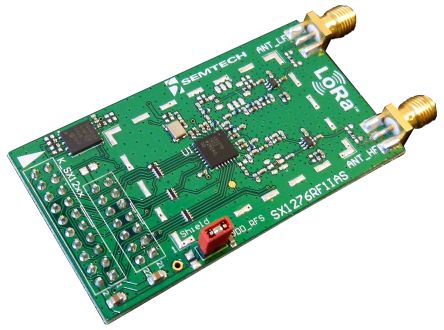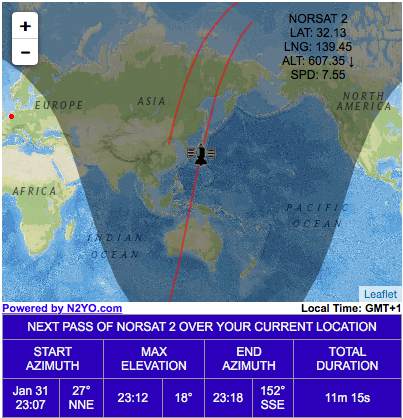You can set a 434Mhz module to 162Mhz, just tried.
RF output is as expected very low, so low that the 3rd harmonic of 162Mhz is a few dB higher in amplitude over the 162Mhz output.
You can set a 434Mhz module to 162Mhz, just tried.
RF output is as expected very low, so low that the 3rd harmonic of 162Mhz is a few dB higher in amplitude over the 162Mhz output.
What about input? Or is that what you mean?
If anyone acquired one of the old LoRa Dev Kits (Dual STM Eiger + LoRa RFM) then there is hope!
The SX1276RF1IAS module (~£65-70) supports/supported 868/169Mhz options.  Would need to hook up to a LoRaWAN protocol handler on back end. (Assuming St Tx is LoRaWAN vs ‘just’ LoRa Phy…). I think Digi, Mouser and some of the other Semtech disties may have stock of the modules if not full kits.
Would need to hook up to a LoRaWAN protocol handler on back end. (Assuming St Tx is LoRaWAN vs ‘just’ LoRa Phy…). I think Digi, Mouser and some of the other Semtech disties may have stock of the modules if not full kits.
It appears to receive at 162Mhz as well, but a few careful checks would be needed to work out how far down in dB the reception is.
Might check later, but I need to pack …
We have a reply from @telkamp !
“An omnidirectional antenna will work fine, we use that too on the roof of the Rockstart building.”
I’ll be trying my luck with the LoPy4 and the HackRF antenna 
Great to see interest in DIY!
The signal is fairly easy to pickup, but you need the right module. The Semtech SX1276RF1IAS for example (Mouser has stock), but HopeRF has an RFM98 version for 169Mhz as well. Ideetron has 4 of those left in stock (select the right version!):
We can of course ask Bart to bring them to the conference.
A 433Mhz module is probably not very well matched at 162Mhz, not sure though how much dB you will loose, and if there’s enough signal left or not.
A good antenna helps a lot, but even a simple wire should pick up something.
I don’t know if the SDR code will work, not sure of that has been tested for negative SNR (which you should expect). Does anybody know? Also the noise figure of the SDR might not be very good, so an LNA is advised.
Remember, the transmissions will stop Saturday evening.
In the messages there is a ‘secret’ code. The first person to post that code on the forum is a hero! The messages are plaintext, not LoRaWAN.
I’ll post the exact details for the receiver configuration later.

I just checked, it’s roughly a 23dB difference at 162Mhz between the 433/169Mhz Semtech reference boards. That will not work.
Ok, too bad, it would have been fun.
We might have some SX1276RF1IAS boards (loan) during the conference.
Yeah…about that…I’m not registered for the conference…so would have been trying to pickup the signal from home.
No problem, I’ll live. 
These are the LoRa settings:
Center frequency: 161.862500Mhz
Bandwidth: 125kHz
Sync word: 0x12
Spreading: SF11
Low Data Rate Optimize: on
Header: on
Coding Rate: 4/8 (this is in the header, no need to configure)
IQ inverted (this is default for rx, don’t change anything)
Set LNA Gain to max (LNA Boost is not supported for the LF port).
idea to recieve with an sdr like ?https://github.com/myriadrf/LoRa-SDR
Is the payload encrypted and do we need the keys ?
No it is in plain text
The signal is live!
Whenever the satellite has view of Amsterdam, it will transmit LoRa messages.

Would be around 23:00CET.
I was doing some checks and I reckon the loss for a receiver listening on 162Mhz with a 434Mhz module is not very great, a few dB maybe. I can explain how I came to that conclusion tomorrow if you like.
Anyway one of my simple Arduino Pro Mini based receivers was propped up against the window of my Hotel room and picked up 5 packets on this evenings 10:12 ish pass, the SNR and RSSI are printed below, but I am only showing the first two characters of the messages, don’t want to reveal the secret;
SNR,-18dB RSSI,-107dB le
SNR,-19dB RSSI,-109dB TT
SNR,-18dB RSSI,-109dB TT
SNR,-17dB RSSI,-108dB le
SNR,-18dB RSSI,-108dB he
SNR is on the limit for SF11.
Not in need of eternal fame and glory? ![]()
(Hiding the other messages until the keynote might be nice indeed.)
No need to spoil the fun for others who may want to try.
One tip I would suggest is that you also display the results for packets that fail packet CRC check. The SX1278 will allow you to print the buffer for a corrupt packet so you can get more clues.